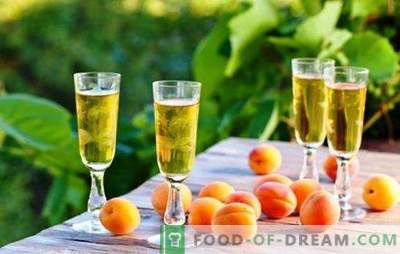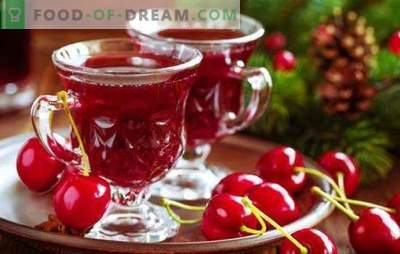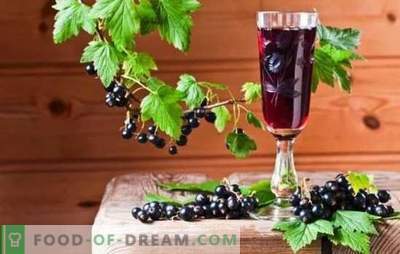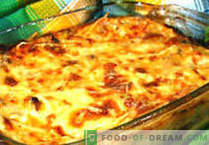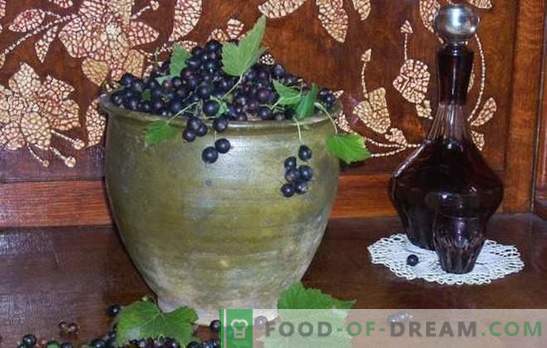
As long as there is a special class among the population of the planet - summer residents, and nature gives people generous harvests every autumn-summer season, the question of homemade fruit and berry winemaking will remain the most pressing topic every year, until the first frosts.
Black currant is the main berry of temperate latitudes, it is associated not only with fragrant and very healthy jam or jam, delicious desserts, pies or sauces for meat. She is an excellent material for inspiration from home-made winemakers and unusual drinks of her own production.
Black Currant Wine - Basic Technological Principles
The preparation of any wine begins with the evaluation of the selected fruit raw materials. For fruit wines, this is not only sorting the material and removing unsuitable berries, but also analyzing the biochemical composition of the wine material.
Since the range of fruit and berry raw materials is too large to dwell on all kinds, we will consider in detail the process of preparing a simple homemade black currant wine, starting with preparing and determining the quality of raw materials and ending with the conditions of its storage.
The process of preparing raw materials begins with the harvest of berries, as soon as dew dries on currant bushes, but the rays of the sun will not be too scorching. Berries must be ripe, but not overripe, to get as much juice as possible. Of course, unlike grapes, it is quite difficult to get currant juice, but for this there are the following simple techniques:
The harvested berries sorted out and, bypassing the washing stage, to avoid the loss of the wild yeast living on the surface of all the fruits, they start preparing mash. Simply the berries are crushed in a meat grinder or crushed, so that the juice is released. Then the pulp is poured with warm (preferably, if purified) water, or prepared syrup, or the sweet juice of other fruits. The temperature of the liquid to be added should be 22-25 degrees. In a word, to improve the juice production, it is necessary to refill, which can cause the fermentation process, during which the thick matter will gradually settle to the bottom of the tank, and small gas bubbles will appear in the separated juice. At this time, you need to decide whether to leave the pulp in the fermentation mash or squeeze the juice and add sugar and yeast to it.
Thick, remaining in the wort, will increase the presence of enzymes, aromatic oils and other substances characteristic of black currant berries, which will make the wine more saturated, bright, with a clearly pronounced aroma of berries. If such a memorable taste is not to your liking and you want to get more muted shades, then it is better to remove the thick.
Actually, it remains to add sugar to the wort, wine yeast or prepared yeast in advance, install a water seal on the bottle to limit the access of air and extraneous microorganisms to “playing wine”, but at the same time, leave an opening for gas , produced by yeast - and you can wait for the end of fermentation.
Of course, it is also necessary to take care of maintaining a constant temperature regime (22-25 degrees) throughout the fermentation, from the turbulent to the quiet and to the full stop. Then you have to wait until the clarification of black currant wine ends, but the wine should be placed in a cooler place (8-14 degrees). After the smallest particles settle to the bottom of the vessel, the wine is removed from the sediment: this is done carefully, so as not to lift the sediment, using a tube that is lowered into two vessels and the wine is pumped into a clean, dry container. If necessary, the removal from the sediment is repeated after 7-10 days.
The whole fermentation process of a simple black currant wine takes no more than 50-55 days. Further exposure time before bottling depends on the particular type of wine and its strength.
A classic raw material in winemaking is grapes. The abundance of wine grapes - the result of the selection work of many people for thousands of years. Of course, preparing the grapes for making wine should also be done, but the acidity, sugar content and juice content in the berries are a matter of course, adjusted by nature and the hard work of the breeders. These three factors are the main components of the future wine. With the fruit and berry raw materials, the situation is somewhat different. The content of acid and sugar in it is different and, depending on the type of berries, in some there may be too much acid, with a clear lack of sugar, and in others, on the contrary - a lot of sugar, but little acid. The pulp of fruit also has a different density, and for this reason, the content of juice in them and the technological methods of its production are also different.
Acidity of black currant wine
A necessary condition for fermentation of the wort and good taste of the finished wine is the acid content in the fruit. During fermentation, lack of acid can trigger an increase in the number of acetic bacteria in the wort. But when brightening wine, which has a lack of acid, the wine will remain cloudy, if it is not added, for example, tannin or other tannic acids. Ultimately, the acid content in wine is important for its taste and storage.
Remember: the acidity for dry wines should be 0.6% per liter of wort; for sweets - from 0.9 to 1.2%; for semi-dry, which are often domestic wines, the normal level is 0.7-0.8%.
The acid content in black currant berries, depending on the variety, is 1.7-3.8%. As you can see, these values exceed the norm by 2-4 times.
During fermentation, part of the acid is lost, so the wort must contain slightly more acid than the already prepared wine. How to determine the acidity of cooked wort in the home kitchen? Unfortunately, only organoleptic way, because the purchase of special equipment for the determination of acidity, which is used in industrial laboratories, will make home winemaking unprofitable.
What to do if you need to reduce the acidity in the wort? Add water or sweet juice, not more than 12% of the total mass of the pulp.
Note that in dry wines that taste more acidic, the acid should be slightly less. There is no mistake or typo in this, because besides acid, the taste of wine creates sugar, and special attention should also be paid to its presence in the wort and in the final product.
Sugar in black currant wine
This product is not only a source of yeast energy. It determines the percentage of alcohol in wine and its taste. That is why a dry wine with a lower strength (9-12%) seems more sour to taste than stronger wines, with a high sugar content, which mutes sour tones of taste.
What else you need to know about the presence of sugar in wine? In large quantities, it inhibits the fermentation process. Sugar - a preservative, which is used for sweet winter preparations precisely in order to suppress the work of the same yeast. Therefore, if you want to prepare a black currant sweet or dessert wine, then all the necessary amount of sugar should be divided into parts, adding one part to start the fermentation and yeast work, and the second after clarifying the wine, during its sealing and ripening.
The strength of the wine is also regulated by the amount of sugar. In some special wines, the fortress is enhanced by the addition of alcohol.
About homemade wine made from black currant and other fruits growing on household plots can be told endlessly, especially since the assortment of homemade fruit and berry wines, as well as the technology of their production, has not been completely investigated by anyone.
Therefore, let us move on to the practical part of the conversation, while summer is in full swing, it is possible to pick berries the next morning and, slightly correcting the recipes offered below, create your own unique and simple homemade black currant wine. We will not waste time and the study of some technological moments we read in recipes, in the process.
Recipe 1. Black currant and mulberry blend wine
As can be seen from the name of the recipe, we will discuss the preparation and mixing (blending) of two sorts of wine: soft, juicy and sweet mulberry fruits, and a more original and pretentious favorite of Russian plains - black currant. Each type of wine at the winery would be prepared separately and only then combined into an exquisite bouquet, but at home you can make it easier: combine the wine material into the total mass and place it in one vessel. It is advisable to choose a white mulberry to make aloe wine with a light currant aroma. Composition:
- Sugar 2.0 kg
- Mulberry 7 kg
- Currant, black 3 kg
- Water 1, 2 l
Cooking:
- Mash mulberry and currant with half the sugar in an enamelled bucket and add water. Stir the wort and tie a bucket with a cotton towel or gauze. Wait until gas bubbles appear on the surface. Before the appearance of abundant foam, wort must be constantly stirred.
- After pouring the contents of the bucket into the bottle and install a water seal. Choose a bottle of such a volume so that 1/4 of it remains empty.
- When all the thick has settled, you can remove the wine from the sediment. Pour the wine into another clean bottle, separating 1 l from it into a 2.5-3 l pot. Add the second part of the sugar to the same pan, stir until dissolved. Pour the wine and sugar from the pan into the bottle. Mix everything together again and install the valve. Then the wine will play quietly.
- The absolute transparency of the wine will signal the end of fermentation and readiness for removal from sediment. The whole fermentation process can take about two months. Pour the wine back into the clean dishes and place the bottle in the basement, where it will mature within 6 months. Bottle and treat your friends.
Recipe 2. Simple homemade black currant and raspberry wine
Composition:
- Berries, fresh (1: 1) 4 kg
- Sugar 1.8 kg
- Water 5 L
- Raisin sourdough 1 l
Cooking:
- The pulp (crushed berries), sugar, water and sourdough mix in a large container (15 l) and pour into the bottle. For 2-3 days, close the neck of the vessel with a cotton swab or tie a gauze.
- In the morning and evening, the bottle should be shaken or stirred the wort with a wooden stick. When rapid fermentation develops, seal the bottle with a rubber glove, with a pre-made hole in one of their fingers, to release carbon dioxide. The glove will first inflate like a ball, and then, conversely, will stick together when the gas from the bottle is completely out.
- Remove the wine from the draft and taste. If necessary (it happens that due to the lack of sunny days, even ripe berries are sour), add sugar and seal the bottle again with the closure until the end of the quiet fermentation.
- If the wine is sweet enough, just drop it in the basement for aging.
- After a couple of months, check for sediment and re-withdraw, even if the amount of settled particles is small. Seal the wine in the bottle.
Recipe 3. Blackcurrant liqueur
Composition:
- Currants 3 kg
- Sugar 2.5 kg
- Blackberry berries 300 g
- Water 3.6 liters
- Alcohol (93.6%) 1.0 l
- Yeast, wine 15 g
Cooking:
- Prepare pulp from currants. Cool boiled water to a temperature comfortable for wine yeast.
- In water, dissolve half the total mass of sugar and yeast, pour the solution into a bottle filled with mash and stir.
- Add mashed black cherry berries to the prepared wort: they contain the tannin necessary for the future wine.
- Further stages of making wine are described in previous recipes.
- Add the rest of the sugar and alcohol to the clarified wine. Stir and soak the drink for another 15 days. The wine should get strong, sweet, with the characteristic aroma of currants.
Recipe 4. Simple homemade black currant and pear wine
The season of picking currants comes before the pears ripen. But the low acid content in pears is perfectly compensated by the acidity of currants. Yes, even the juiciness of the pear can be compensated by the lack of juice in black currant. Therefore, gathering currants, preserve it, chafing with sugar, to later add the ready-made pulp to the fruits of pear.
Composition:
- Pear, sweet 5 kg
- Currants 6 kg
- Sugar 4 kg
- Tannic acid 30 g
- Water 3 L
Cooking:
- Currant, sort, wash, lightly dry, grind with sugar using a meat grinder. Spread in dry jars, sprinkle grated berry with sugar in each jar, tightly close the nylon caps and store in the refrigerator.
- Free ripe sweet pears from seeds, “tails” and chop. In a pear pulp lay out the currants rubbed with sugar. Stir by adding tannic acid and cover the pan before fermenting the wort. Fermented juice is easier to separate from the hard particles of the fruit. Pour it into the bottle and close the neck with gauze.
- Fill in the thick with warm boiled water and leave for a day warm. When the water infusions and absorbs the remaining sugars and enzymes in the thick, strain it and wring it out. Add water to the bottle and install a water seal.
- Further process of making wine, see recipe number 1.
Recipe 5. Red black currant and gooseberry wine, dessert
Composition:
- Gooseberry 4 kg
- Currant, black 3 kg
- Water 3.5 L
- Sugar 4.5 kg
- Wine yeast 10 g
- Oak leaves, fresh 200 g
Cooking:
- To prepare the wort, dissolve 2 kg of sugar in heated to 22 degrees purified (or distilled) water (1.5 l).
- From the collected and sorted berries make pulp. Combine the pulp with sweet water and yeast.
- Place the mash for fermentation in an enamel bowl, covering it with gauze or a towel. As soon as the mass foams, squeeze the juice out of it. Fill in the remaining water with the remaining water, warm it up and, after cooling, press it again.
- Combine the fermented water with fermented juice and add yeast. Pour the liquid into the bottle, place the finely chopped oak leaves. After setting the water stop, put the wine to ferment.
- When it is completed, wait until the wine is clear and remove it from the sediment. Add sugar to the clarified wine and send the wine for aging. After 2-3 months you can try. If sediment forms again, repeat the removal.
Black Currant Wine - Tips and Tricks
- Do not store wine in sediment bottles, because it contains yeast residues that will eventually spoil the taste of the wine and make it bitter, with an unpleasant smell.
- Fermentation and storage of red wines, including berry ones, is best done in a place protected from the sun. Red berries contain an enzyme that burns out in the sun, causing harm to the quality of red wine.


